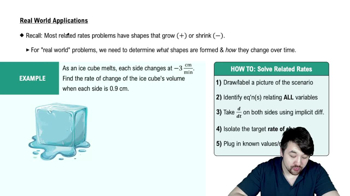Table of contents
- 0. Functions7h 52m
- Introduction to Functions16m
- Piecewise Functions10m
- Properties of Functions9m
- Common Functions1h 8m
- Transformations5m
- Combining Functions27m
- Exponent rules32m
- Exponential Functions28m
- Logarithmic Functions24m
- Properties of Logarithms34m
- Exponential & Logarithmic Equations35m
- Introduction to Trigonometric Functions38m
- Graphs of Trigonometric Functions44m
- Trigonometric Identities47m
- Inverse Trigonometric Functions48m
- 1. Limits and Continuity2h 2m
- 2. Intro to Derivatives1h 33m
- 3. Techniques of Differentiation3h 18m
- 4. Applications of Derivatives2h 38m
- 5. Graphical Applications of Derivatives6h 2m
- 6. Derivatives of Inverse, Exponential, & Logarithmic Functions2h 37m
- 7. Antiderivatives & Indefinite Integrals1h 26m
- 8. Definite Integrals4h 44m
- 9. Graphical Applications of Integrals2h 27m
- 10. Physics Applications of Integrals 2h 22m
4. Applications of Derivatives
Related Rates
Problem 96c
Textbook Question
Right circular cone The lateral surface area S of a right circular cone is related to the base radius r and height h by the equation
______
S = πr √ r² + h².
c. How is dS/dt related to dr/dt and dh/dt if neither r nor h is constant?
 Verified step by step guidance
Verified step by step guidance1
To find how dS/dt is related to dr/dt and dh/dt, we need to use implicit differentiation on the given formula for the lateral surface area of the cone: S = πr√(r² + h²).
First, identify the variables: S is the lateral surface area, r is the base radius, and h is the height. Both r and h are functions of time t, so we will differentiate with respect to t.
Apply the product rule to differentiate S = πr√(r² + h²) with respect to t. The product rule states that d(uv)/dt = u(dv/dt) + v(du/dt), where u = πr and v = √(r² + h²).
Differentiate u = πr with respect to t to get du/dt = π(dr/dt).
Differentiate v = √(r² + h²) with respect to t using the chain rule. The derivative of √(r² + h²) is (1/2)(r² + h²)^(-1/2) * (2r(dr/dt) + 2h(dh/dt)).
 Verified video answer for a similar problem:
Verified video answer for a similar problem:This video solution was recommended by our tutors as helpful for the problem above
Video duration:
4mPlay a video:
Was this helpful?
Key Concepts
Here are the essential concepts you must grasp in order to answer the question correctly.
Related Rates
Related rates are a concept in calculus that deals with the relationship between different rates of change. When two or more variables are related by an equation, the rate of change of one variable can be expressed in terms of the rate of change of another. In this context, we are interested in how the lateral surface area of a cone changes with respect to time as both the radius and height change.
Recommended video:

Intro To Related Rates
Differentiation
Differentiation is a fundamental concept in calculus that involves finding the derivative of a function. The derivative represents the rate of change of a function with respect to its variable. In the context of the given problem, we will differentiate the surface area equation with respect to time to find the relationship between the rates of change of the radius, height, and surface area.
Recommended video:

Finding Differentials
Chain Rule
The chain rule is a formula used in calculus to compute the derivative of a composite function. It states that if a variable depends on another variable, which in turn depends on a third variable, the derivative of the outer function is multiplied by the derivative of the inner function. In this problem, we will apply the chain rule to relate the rates of change of the surface area, radius, and height of the cone.
Recommended video:

Intro to the Chain Rule
Related Videos
Related Practice





